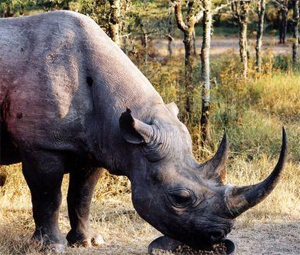First captive black rhinos released into the wild in 25 years
Jeremy Hance, mongabay.com
October 3, 2008
Fifteen critically-endangered black rhinos have been released at an undisclosed location in Kenya with hopes that this pioneer group will breed naturally, repopulating an area they once roamed abundantly. The release is the first time in 25 years that captive rhinos have been returned to the wild.
Overseen by the Kenyan Wildlife Service and the Zoological Society of London (ZSL), it is hoped that the release will be the first of many. According to an article from ZSL the fifteen rhinos were sedated and had GPS transmitters installed in their horns before being moved to their new home. The fifteen individuals were selected from a single herd, so the animals would already be familiar with one another. If the release proves successful, ZSL hopes to take what is has learned in Kenya to Uganda and Tanzania for similar projects there.
Kenya once had as many as 20,000 black rhinos. In two decades that number dropped to 350, largely due to poaching for their horns for markets in Asia and the Middle East, which use the horns for medicinal purposes. Currently Kenya’s black rhino population has been growing slowly but steadily: about 500 black rhinos live in wildlife sanctuaries.
 Black rhino |
According to an interview with the BBC, the Kenyan Wildlife Service’s hopes to have 2,000 black rhinos roaming wild. While this is only 10 percent of their historical population, it would be a major success considering how close the black rhino came to outright extinction.
There are four subspecies of black rhino, three of which are critically endangered and one extinct. In 2006 researchers failed to find any West African black rhinos in their last stronghold in Cameroon, leading to the announcement of its tentative extinction. The black rhinos in Kenya belong to the subspecies of the East African black rhino.
Black rhinos can be distinguished from the more populous white rhino in Africa by their smaller size and lack of a hump. They also have a prehensile upper lip which they use to feed on a variety of plants, whereas the white rhino has square lips for its grass-heavy diet.







